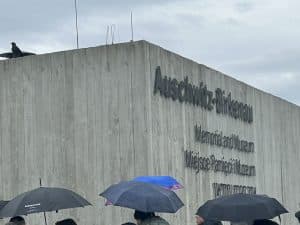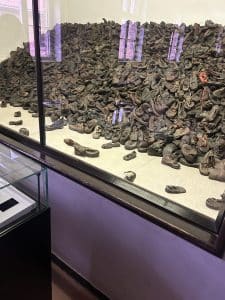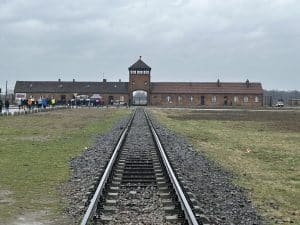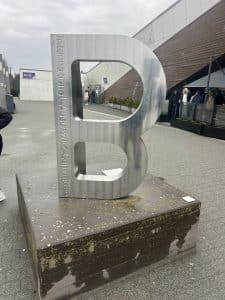This is a very different experience from the last post, about Hallstatt, Austria. My work covers a lot of different things, including conflict sites and how sites primarily associated with death and destruction are memorialized and presented to the public. I have published about this some, and it’s an ongoing area of fascination. So, as I was crossing across southern Poland, it was important to see how Polish state officials and heritage professionals built the interpretation of perhaps one of the darkest, most soul-destroying places on earth.
I took a tour of Auschwitz.
First, understand that there is a really fascinating body of literature out there on the history of interpretation and preservation of the site, which was first set aside for some form of memorialization in 1946. As with many sites made significant by their connection to death and suffering, interpreting the site to the public is unendingly complex and contested. Was the site primarily about an outrage against the people of Poland (Jewish and gentile), or was the Jewish connection salient? How are different aspects of such a place to be presented to the public? How do you convey the depths of what was done to people (including thousands upon thousands of children) in a way that does not downplay but also does not sensationalize the violence?
Second, my experience was through a tour, one of dozens that was going through the site that day. You can also tour it on your own, taking more time if you like, but you need to bring your own preparations.
Presenting Mass Murder to the Public
Perhaps the best starting point for talking about this is noting the degree of preservation of the site. The brick buildings that comprise Auschwitz (technically, Auschwitz I… more on that later) largely still stand, meaning that the public can move through the space much as the victims did during the genocide. Certain parts have been rebuilt, like the “Wall of Death” next to Block 11, but most elements remain in place. This includes the gas chamber that was used early on at the camp, which the tour walks visitors through, allowing them to see where people were herded, killed, and then (in the adjoining space) cremated. It is a frank and somber experience, as the guide was careful to point out how small pieces of the camp’s built environment were used for killing and torture. It surrounds you from the moment you pass through the infamous “Arbeit Macht Frei” of the main gate.
Some of the most powerful ways that the museum conveys the deep meaning of the site is through artifacts. They display the eyeglasses, luggage, shoes, cooking implements, and other things that the victims brought with them on their trip to the camp. They also have an entire wall case containing the hair of 40,000 women whose heads were shaved before they were murdered in the gas chambers. The museum has one of the detention blocks, Block 11, which was used as a disciplinary barracks, set up as it would have been when the camp was in operation. This includes detention cells in the basement set up either as dark cells, starvation cells, or special punishment cells measuring 1 square meter where four (FOUR) people would be made to share for hours on end. It also contains the cell where Zyklon B, the gas used to murder millions, was first tested on Soviet POWs early in the camp’s history. They use both real Zyklon B crystals (obviously sealed behind glass) and expended containers to underscore its use.
As hard as Auschwitz is to experience, it should be remembered that “Auschwitz” is often a gloss for “Auschwitz I,” the first camp. Little prepares one for the second half of the tour, Auschwitz II – Birkenau, often called simply “Birkenau” (there was also Auschwitz III – Monowitz in Oswiecim). Birkenau has the iconic railroad gate through which hundreds and hundreds of thousands of people were shipped, of whom at least 80% were sent immediately to the gas chambers, and the remainder were put to labor until they died. The gas chambers and crematoria are still there, despite being blown up by the Nazis when the camp was closed. Birkenau is jaw-dropping for its sheer expanse, the number of barracks that were once there (up to about 300), and the lack of pretense about the site being anything but a landscape for murdering people in vast numbers. The guides took us through one of the barracks, which somehow once held over 700 people.
So, this was a hard day. It is hard to walk through there and not consider what would have happened to my family had we been sent there. There was one small glimmer of… not “hope” and certainly not “joy,” but… maybe “light?” in that space. The main gate at Auschwitz is the one that has the iconic “Arbeit Macht Frei” worked into it. The eagle-eyed among you will note that the “B” in “Arbeit” (German for “work”) is upside down. This is, apparently, a deliberate act by the victims who were forced to construct the gate, a small challenge to the insanity of what was taking place there. The upside-down “B” was taken on a symbol of resistance after the war and was made into a statue near the Birkenau gate. It was donated by workers from Volkswagen (a company that used enslaved labor during the war, it should be noted).
Notes on Memorialization
There were a couple of interesting things about how the site was managed that seemed important to note. First, when you enter the site you have to go through metal detectors. The only other museum I can recall having to do this at is the National Civil Rights Museum in Memphis. That’s an interesting convergence, no? Second, though there hasn’t been a ton of archeological research at the site, as far as I know, the use of artifacts to tell the story of the people who endured the site, and the ends that they suffered, was crucial to conveying the power of the place. The ashes of the victims were frequently dropped in the local rivers or used as fertilizer on local fields, so there is no mass grave containing the 1.4 million (MILLION) people who were murdered there, a point that Holocaust deniers often lean on. That brings up another thing. Our tour guide had two recent instances in which people were removed from the tour and the site for attempting to use their access to the site for public celebrations of Hitler and what took place there. There is clearly no space given to celebration or denial of the site. There shouldn’t be.
One thing came up at the end of the conference, well after the visit. As I was on the train towards Krakow, an ad came on one of the TVs for a museum dedicated to the residents of Oswiecim that colluded to subvert the Nazi works there. That aspect of the history was really not substantially emphasized in the camp, itself. I also thought it was interesting that the ad was only in English, not Polish and English like the others they were showing. It seemed a little bit like projecting something primarily to tourists…
Finally, I noticed that our tour guide consistently described the murders as “Nazi Germans,” not “Germans.” She was asked about it at the end of the tour and she talked about how this was a deliberate choice to place emphasis on them being Nazis. This was less about exonerating non-Nazi Germans (who committed plenty of their own atrocities throughout the war), but emphasizing that Nazis are still with us, not just in Germany. There are Nazi Germans, yes, but also Nazi Poles, Nazi French, Nazi British, etc., and that’s the real threat here. It’s the ideology, not the ethnicity.
Side/Additional Notes
- The gift shop has basically only books and a few refrigerator magnets. Because how would you sell a t-shirt or a Lego set for this place?
- Scholars have pointed out that the landscape of the heritage tourism industry around there is a little tough for the city of Oswiecim, where the camp was built. Most of the tours come in from neighboring Krakow, so the local town doesn’t benefit as much as you might like to think.
- The literature around the site points out that the camps were only one part of the city being created as a Nazi model community, which involved the forcible deportation of the prewar population, the administrative folding of the town into “German” territory, and the influx of German settlers who were to set up a Nazi utopia in western Poland. This isn’t really addressed in the public interpretation, but it matters in that the current populace of Oswiecim basically isn’t descended from the people who lived in the town during the war.
- Much like Arkansas, most businesses are shut down or on limited hours on Sundays. Luckily, the pierogi place near the train station was open and was lovely. Feels weird to comment on something like that given the weight of the rest of the trip, but there it is…
- Weird but I have yet to have a hotel room that doesn’t require you to have the key to open the door from the inside. Panic hardware isn’t a thing here, I guess.






